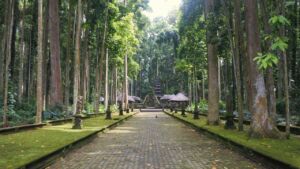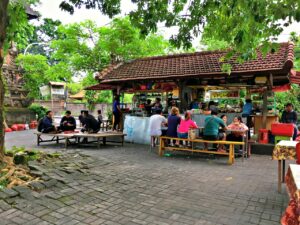Picturing a Balinese Pura (temple) in mind. People often imagine a Hindu place of worship with crowds of pilgrims coming and going. However, this is not the case with Taman Ayun Temple in Mengwi Village, Bali. If one word describes Taman Ayun, it is “tranquil”. Taman Ayun is more of a serene garden than a busy temple.
This can be true because Taman Ayun means “beautiful garden”. It is built in 1634 not only as a place of worship. But also a recreational park for Mengwi Kingdom’s royal family. Back then, commoners were not allowed to go in. The temple has shrines dedicated to royal ancestral spirits and the Hindu gods.
It is a special place where kings pray and pledge for their kingdom’s prosperity. Taman Ayun Temple underwent a major renovation in 1937. Several things have also changed since. No longer exclusive to the royal blood. This temple is now open for all Balinese to pray.

And as a recreational place, the park is a favorite spot for a family outing regardless of social status. UNESCO recognized this temple as a world heritage site in 2012.
Taman Ayun Temple Entrance Fee
Compare to other temples in Bali, the entrance ticket is quite cheap. The admission ticket for international visitors is Rp30.000. Prepare a sarong to cover both knees as Taman Ayun is no different than any sacred temple in Bali.
| Taman Ayun Temple Entrance Fee | |
| International tourists | Rp30.000 |
Nearby: GWK Cultural Park & Theather Schedule.
Taman Ayun Temple Opening Hours
The temple is open every day from 8 AM to 6 PM. The best time to visit is around sunset. Where the golden sky stretches beautifully behind the temple’s pagodas.
| Taman Ayun Temple Opening Hours | |
| Every day except in Nyepi | 08:00 – 18:00 WITA |
Nearby: Kecak Dance Performance in Uluwatu Temple.
Mandala The Inner Shrine
The main sight of Taman Ayun is the inner part of the temple called “Utama Mandala”. The beautiful architecture of Utama Mandala is attributed to its stone-based shrines. With a high cascading roof known as Meru. The Meru believe as a temporary place for the god during ceremonies.
Its height represents the deity’s importance. The highest, the 11-tiered roof, is dedicated to the Hindu main Gods, the Trimurti. A moat circles the compound, giving the illusion that the temple floats gracefully on the water. Back in its glory days, the royal women loved sailing canoes on this little river.
Those days are gone as the old kingdom has long perished. The moat instead has become a home for blooming blue water lilies. And occasional frogs hopping in between – also a pretty sight on its own. The Chinese-influenced carvings on the shrines make it hard to resist not examining them closely.

Climbing The Towers
It is also tempting, as it is contemplative, to walk around the temple like a king of olden times. However, prepare to be slightly disappointed. In order to preserve the delicate structures, the inner area is closed to tourists. Visitors can only observe from behind the low stone wall surrounding the temple.
There are two 7-meter tall bell towers standing outside the temple’s “Candi Bentar” gate. Known as “Bale kulkul”, the bell towers relay information. Or signaling the religious activities. The good news is these towers are not off-limit. Tourists may climb these towers. The towers also provide a nice view of the inner temple’s area.

Taman Ayun Temple The Artist Corner
Bale Loji pavilion, in the central courtyard, was a resting hall for priests between ceremonies. It now serves as an artist corner. Witness some daily art-in-the-making: either painting, carving, or sculpting. Besides taking a quick tour of the arts displayed in the Bale, visitors can also buy them.

The price varies, for example, a 40×40 cm painting costs Rp200.000 to bring home. There is a cockfighting diorama near the art pavilion. It might look inhuman, but cockfighting was a perfectly acceptable entertainment in medieval Bali.
Along with this diorama, there is also a part of the pavilion serving as a small museum. This museum provides information about Taman Ayun Temple’s history.
A Small Forest Behind Taman Ayun Temple
If visitors continue to walk past the inner temple, there’s a park as large as the temple itself. Take a tranquil walk to clear the head or take shade at one of the gazebos. There is signage on every important tree.
Helpful information to know more about tropical plants covering the area. Staying near the area, take a jog. The small forest is also known for its scenic jogging trail.

Manusa Yadnya and Ogoh-Ogoh Museums
Don’t end the Taman Ayun Temple tour without going to the museum. Check out the two museums right in the west of the temple’s complex. First, the Manusa Yadnya Museum is open every day and tickets are free.
Learn about the cycle of human life according to Balinese belief here. From birth to death. There are various ceremonies that need to be done in each phase of life.
Ogoh-ogoh museum across the road is a museum about Hindu deities. The museum exhibits statues of all sizes, depicting Shiva, Brahma, and other Hindu gods. Impressive details on these statues will keep visitors occupied for another 15 minutes.
However, perhaps parental guidance is needed when bringing small children. The deities are depicted in a scary way and some of them are quite graphic.
See: Sangeh Monkey Forest, Temple & Activities.
Facilities
The officials at Taman Ayun temple maintain the place really well. Bathrooms are not only available but they are clean. Unlike typical bathrooms at other tourist sites. The temple also provides a sarong for anyone who doesn’t bring one. Something that’s also rare.
No food vendors inside the premises, but they are available just across the road in front of the temple’s entrance. As for accommodations, hotels and lodges are plenty at Mengwi village nearby.
See: Bali Airport Guide & Transportation
How To Get To Taman Ayun Temple
The temple is 40 minutes from Denpasar. Visitors only need to follow Cokroaminoto street and take a right turn to Denpasar-Gilimanuk street. Continue to drive for 12 km to I Gusti Ngurah Rai street then turn right to Ayodya street where the temple is located.
Visitors can rent a scooter or a car to get there. For tourists opting for public transport, hop on a bus with route Denpasar-Singaraja or Denpasar-Bedugul. Ask the driver to stop at the Mengwi village crossroad. From there on, walk 250 m to the location.
See: Indonesian SIM Card, Price & Coverage
Address & Location
Taman ayun temple located in Jl. Ayodya No.10, Mengwi, Badung, Bali 80351.







